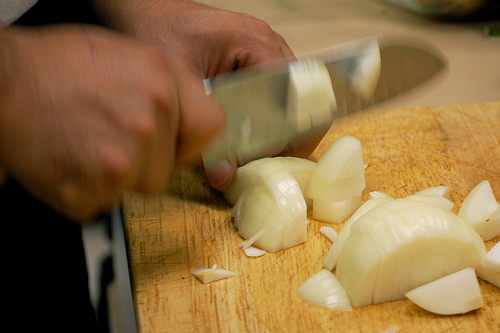
Onions are not only one of the most versatile veggie staples in the kitchen, they’re also easy to grow, plus onion types and varieties are endless. There’s also the many health benefits they can provide such as lowering the risk of cancer and heart disease, as well as being a great source of fiber, and vitamins C & B6.
So why all the tears? Well, once you take your knife to an onion, enzymes and amino acid sulfoxides come together to create a volatile sulfur compound (in the form of a gas). This is what turns on the water works. Your eyes are attempting to wash away the offending gases.
You’ll notice the biggest tear reaction when the root part (or basal plate) of the onion is cut off. Below are the best suggestions from cooks everywhere on how to dry those tears.
- The first suggestion that everyone seems to agree on is that you should be using the sharpest knife in the house on onions. There’s a couple reasons that this helps: because the enzymes are released when certain cells are broken, a sharp slice avoids actually crushing them and thus releasing less gas. The other more obvious reason is that a sharp knife allows for faster slicing, which lessens the time that your eyes are actually exposed to the tear-jerking fumes.
- Cutting an onion underwater is a popular tip that seems to work well. Along the same lines is to slice them near running water or steam from a kettle. Although personally, I’ve tried this near running water and it didn’t work for me. (Let me know if you’ve had success with this technique).
- Seems obvious, but it’s worth mentioning to chop onions near on open window, well-ventilated area, or fume-sucking fan to keep the gas that reaches your eyes at a minimum.
- The basal part of the bulb (where the roots are) holds the most sulfuric compounds, so if you can cut off that area last, you’re ahead of the game. And once you do get to that point be sure to point the bottom or the top of the onion away from your face as you cut (the onion “sprays” juices from these areas).
- Some claim that if you concentrate on breathing through your mouth instead of your nose, your tear ducts won’t produce tears as the olfactory nerves aren’t triggered. Along the same lines are to stick your tongue out so the gasses waft across your tongue which prevents the tear trigger, too. I’m trying this particular tip next time.
- You can always wear safety-type glasses as a physical barrier. But don’t forget regular reading or sunglasses won’t work — they need to be tight against your face.
- Many people swear by chewing gum while preparing onions. This one seems a little suspect to me, so let me know if it’s worked for you.
- Supposedly, those onion gasses find fire irresistible. So, it’s recommended that you light a candle near your cutting board before you start chopping.
- Vinegar is said to denature the onion’s enzymes and to add some to the cutting board. I have no idea how much vinegar this would entail. Try it and report back, okay?
- Salt is suppose to denature the enzyme as well. So some people soak the onion is salt water before preparation is another suggestion I’ve heard about. The salt is suppose to denature the enzyme as well.
- Last, try putting the onion in the freezer for about 15 minutes before slicing into it.
- This is a sure way to at least reduce the amount of gas that’s released during preparation and, therefore, reduce the amount of time spent crying over dinner.
Have any more no-more-tears onion prep tips? Let us have ’em!
|
More on onions… Homegrown/Homemade Video Series: Onions Video: How to Slice and Dice an Onion (FineCooking.com) |


















Comments
Log in or create an account to post a comment.
Sign up Log in